By 2023, mobile apps are expected to generate $935 billion* in revenue and by 2024, around 184 billion apps will have been downloaded*. While keeping these predictions in mind, let’s rewind and consider app stores’ humble beginnings.
2008: The Apple App Store launched in July*, followed by Android Market in October (it became Google Play in 2012)*. To refresh your memory, here’s what the stores looked like in 2008.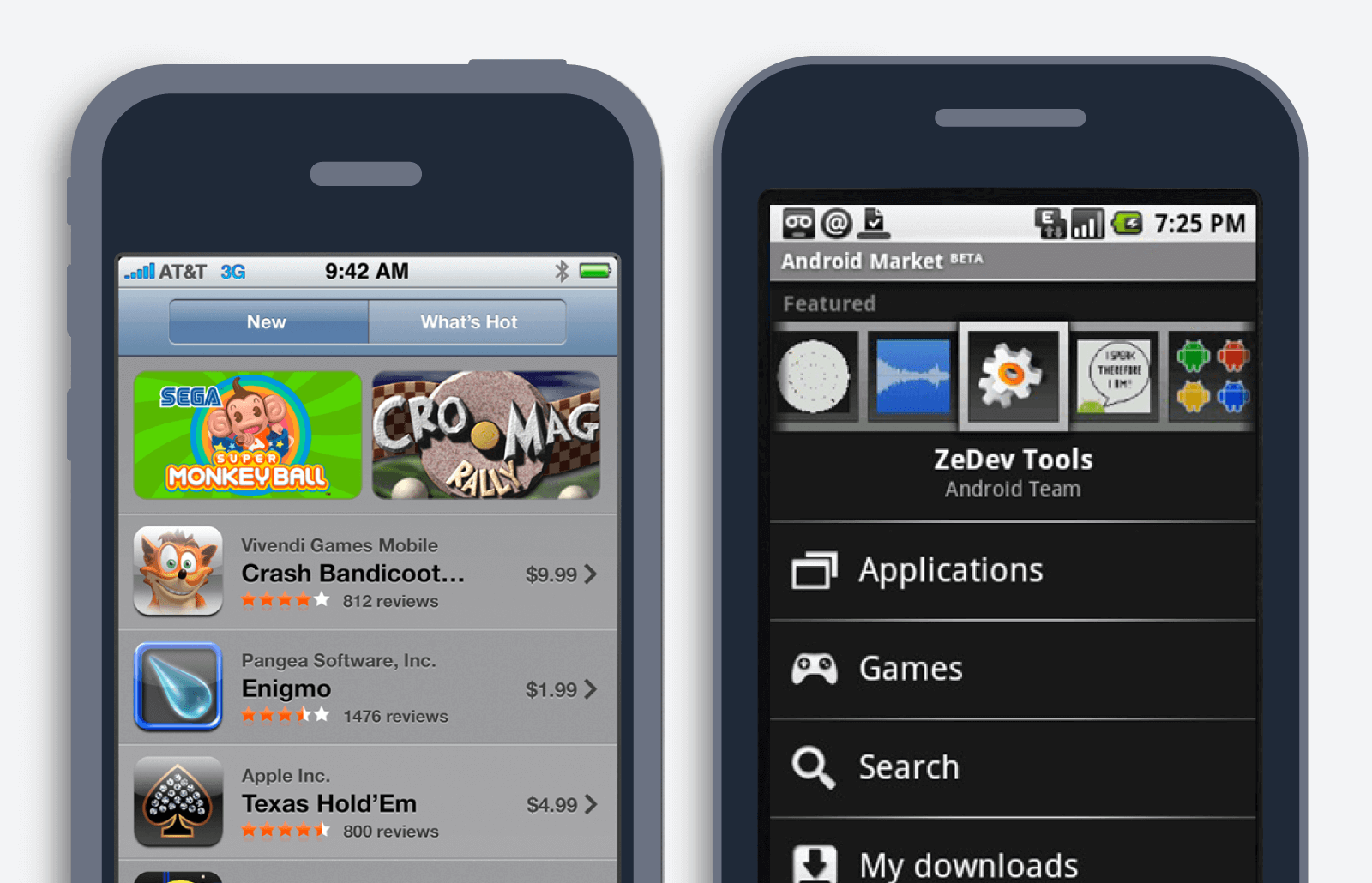
It’s fair to say that since then, the stores have undergone significant changes in design, functionality, and app databases. However, the aim of these stores remains the same: to provide a platform for mobile users to browse and download apps. Apps are so much a part of our lives that Apple and Google release annual roundups of the best apps and games.
In 2020, the App Store announced that Wakeout!, a family-friendly exercise and movement app, earned the iPhone App of the Year*. The app also won app of the year in 2017. For Google Play, there was a similar theme to its 2020 winner. Mood-altering app Loóna won best app of the year, and according to Google Play data, it’s been downloaded 500,000 times.
For these app developers, it must feel great to receive this recognition from Apple, Google, and, of course, their users. However, for every success story, there are hundreds of apps that fail. According to a 2018 Gartner study, less than 0.01% of consumer mobile apps will be considered a financial success by their developers*.
With millions of apps now available in Google Play and the iOS store, how many have missed the mark with consumers? In this roundup, we highlight 11 apps that came up short, and crucial lessons that developers and marketers can learn. Check out our infographic below to learn how to win from mobile app failures.
Why Do Mobile Apps Fail? A Few Theories
With a 0.01% success rate, why do app developers even bother? While there are a number of theories as to why mobile apps fail, the main reasons fall under these three categories:
1. There is such a thing as a free app
According to Statista, as of March 2021, 93% of all iOS applications were available for free compared to 97% in Google Play*. With so many free apps available, it’s no wonder that users are hesitant to pull out their wallets for apps that have a price tag. This makes it difficult to monetize apps and pump money back into app development.
2. There are so many apps
In the time it will take you to read this article, thousands of apps were added to the Google Play store. In fact, 3,739 apps are added to Google Play every day*. The demand for new content has driven the global mobile industry and widened the app pond. However, progress is a double-edged sword and this demand and growth means more competition. Bottom line: the definition and standards for the ‘best’ app are harder to match.
3. There is a hefty build cost for an app
According to industry insiders, it can cost as little as $1,000 for a simple iOS app and as much as $150,000 for a high-tech Android app*. It can be a tough place to start, and as a result, profitability and future investment can be difficult to maintain for a large number of apps.
Failure to Launch: 11 Mobile Apps That Lost Their Value
With all of this in mind, we decided to look at 11 mobile apps across gaming, technology, media, transportation, social networking, ecommerce, and finance that failed to stay the course.
Yik Yak
- App Life: 2013 to 2017
- Synopsis: An anonymous, location-based messaging app for college students
- Market: Social networking
- Claim to fame: Investors once valued Yik Yak at $400 million
Why it failed: This was an initially popular app that didn’t have a business model or firm understanding of its product or market fit. The anonymity that once attracted users to the app later resulted in serious complaints around cyberbullying, threats, and harassment. User growth slowed, employees sadly lost their jobs, and the app shut down after only four years.
Key takeaway: Don’t just focus on your product. Before you launch an app, ensure that you thoroughly research and understand your product-market fit. How do you keep users happy with your app and how do you increase time spent on the app? How do these answers contribute to your ongoing success and product growth?
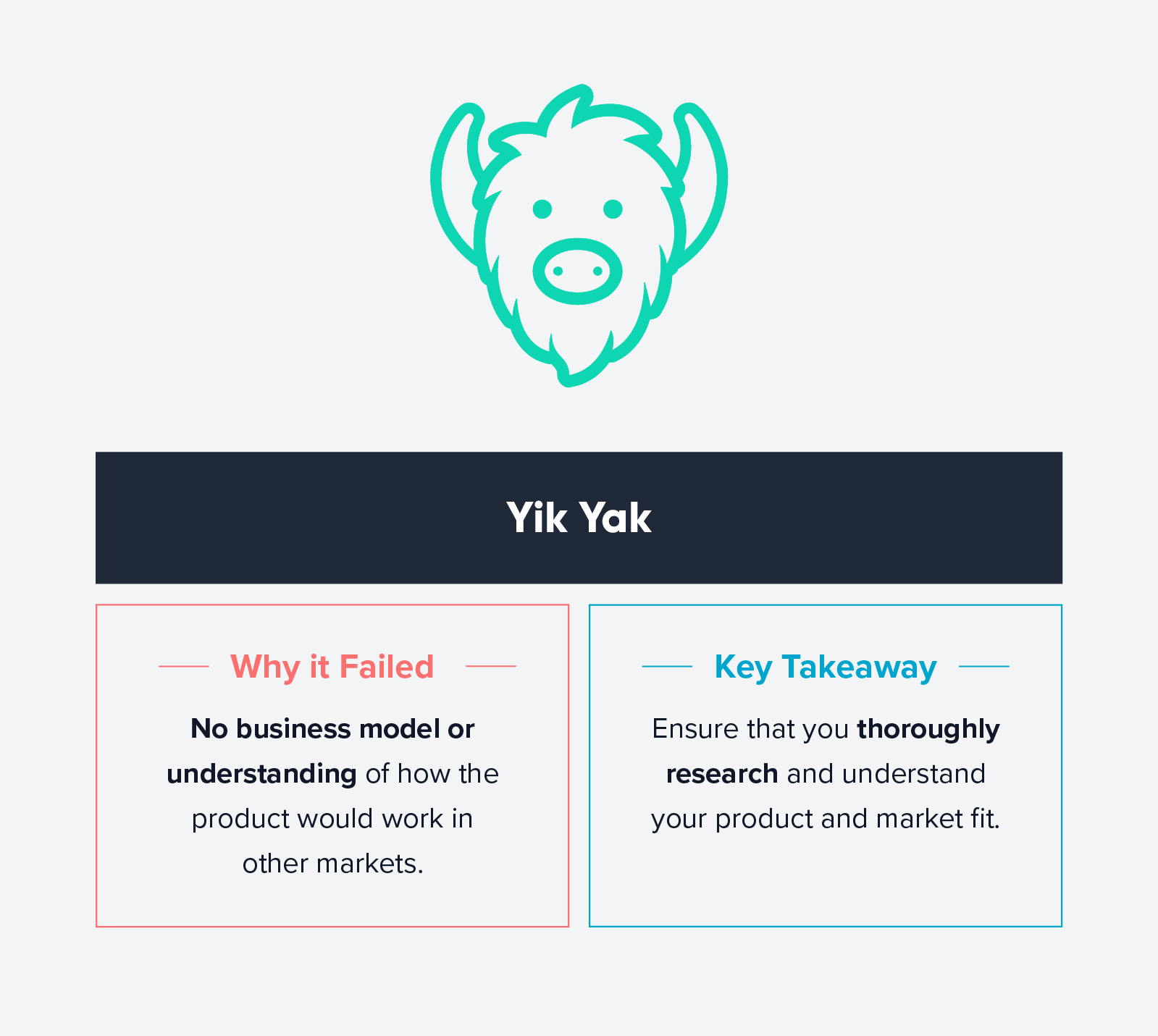
Hailo
- App Life: 2012 to 2014 (North America market)
- Synopsis: British-born taxi app that matched passengers with taxi drivers
- Market: Transportation
- Claim to fame: In 2013, the app had 30,000 drivers and 2.5 million users
Why it failed: While the app still operates in Europe, it failed in North America, particularly when it launched in New York City. Here’s why: the app assumed that drivers in NYC were the same as drivers in London. In NYC, cabs are not seen as a luxury like they are in London. Additionally, London has tricky routes while NYC is on an easy-to-use grid system. It also didn’t help that Uber also launched in 2011 and was on track to dominate.
Key takeaway: It might sound like common sense, but no two users are the same. The same goes for markets. Don’t base your decisions and assumptions on cookie cutter versions of one successful launch. You might have a great idea, but you have to put in the work to succeed. 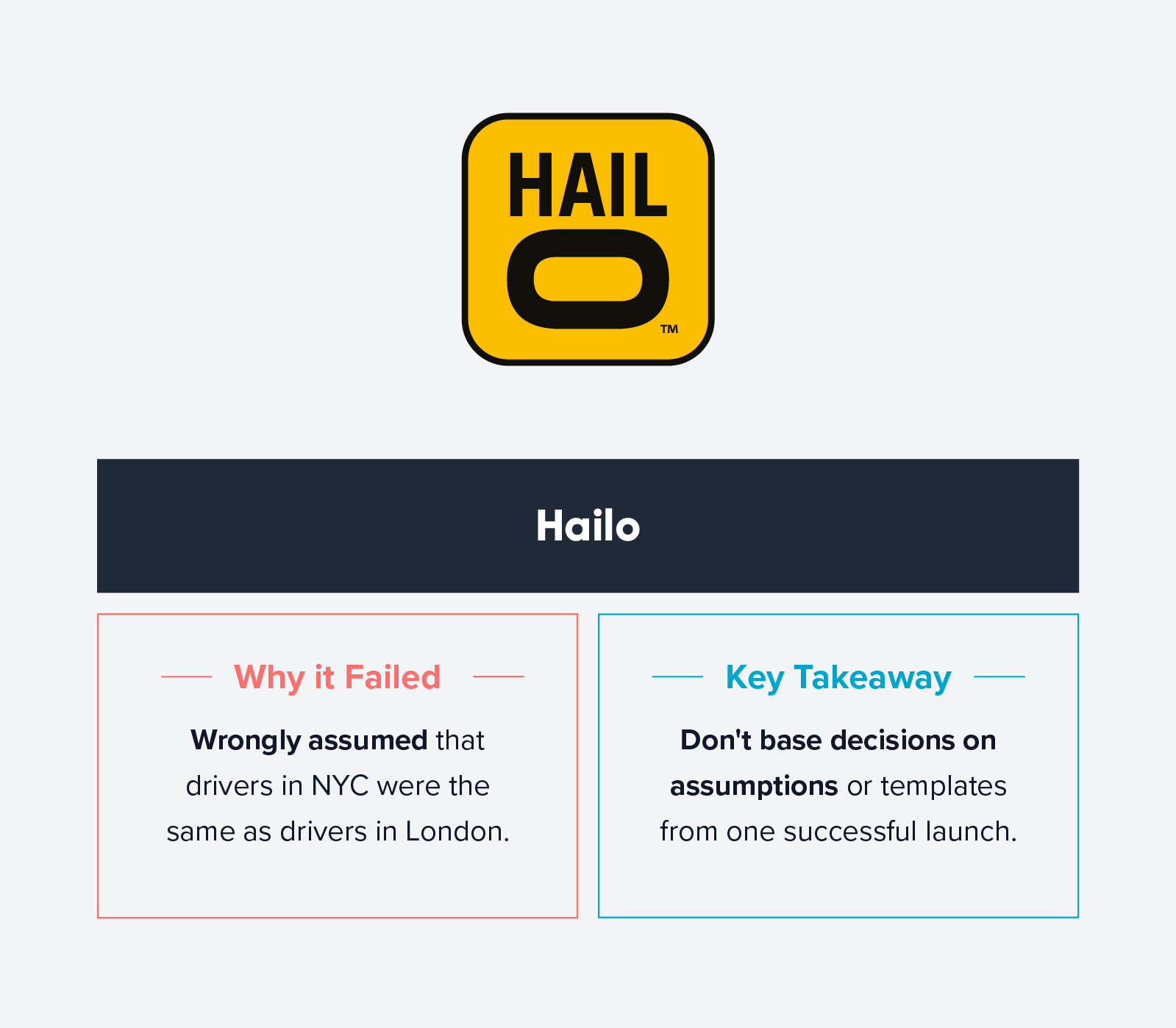
Vine
- App Life: 2012 to 2017
- Synopsis: A popular app for making short-form videos
- Market: Social networking
- Claim to fame: Twitter bought the app in 2012 for a reported $30 million
Why it failed: The short answer: Instagram and its 15-second video capability. While Instagram wasn’t the only contributor to Vine’s demise, it played a big part in it. As downloads and users declined, so did advertisers and marketers that once considered Vine the platform to invest in. Other issues included an unsustainable business model and inability to adapt and compete with other apps.
Key takeaway: You’ll always have competition, but there are a couple of important elements of success: recognizing and embracing change. As technology evolves, so will the needs of users. If you stick with what you know and miss the boat, it will literally be sink or swim time for your app. 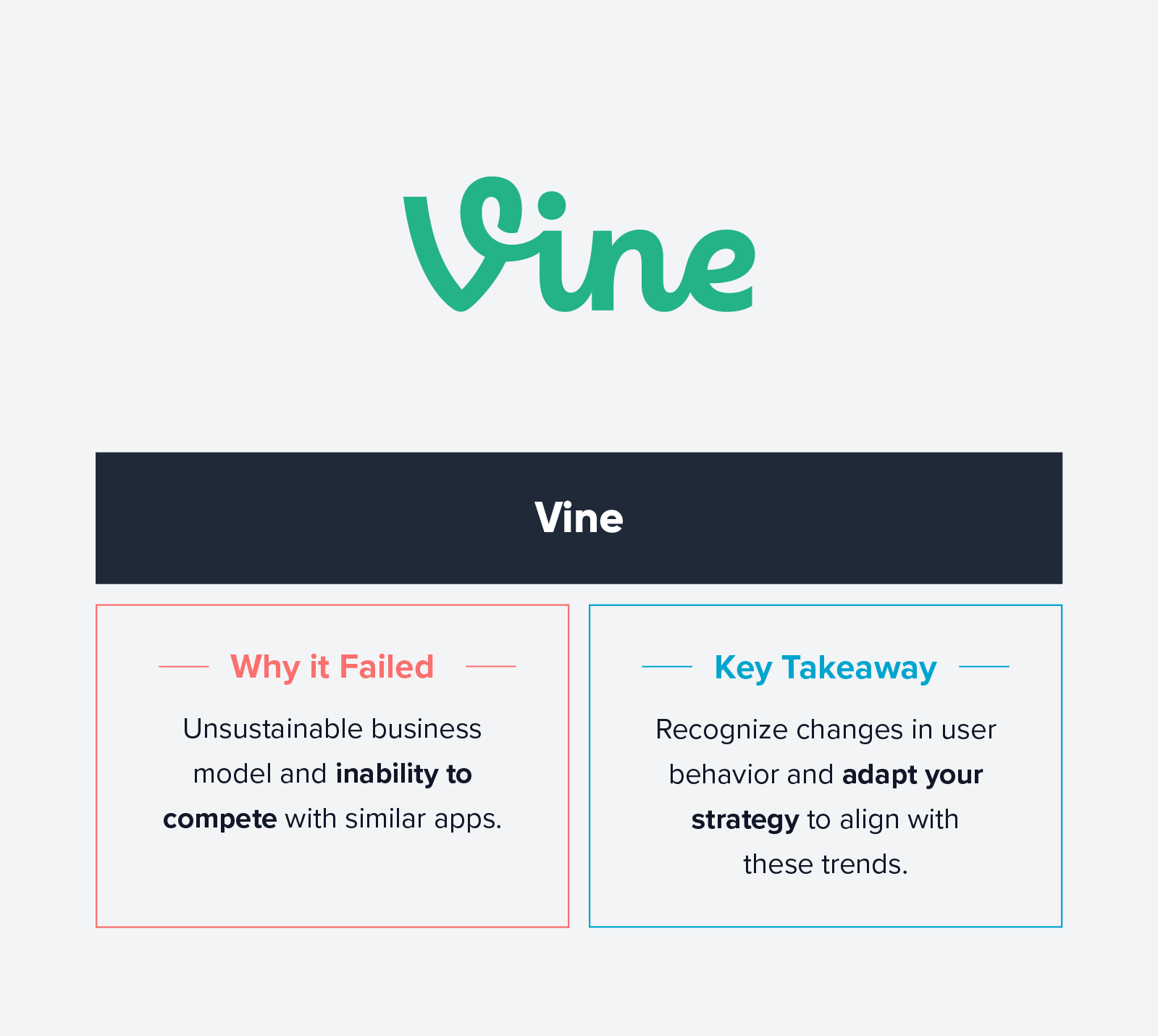
Quibi
- App Life: April to October 2020
- Synopsis: A short-form video streaming service
- Market: Media and entertainment
- Claim to fame: The app successfully raised $2 billion before launch
Why it failed: One big reason was the app did not have memorable, binge-worthy content. The app also only planned on people wanting to watch content on their phones. There was no compatible Fire TV app or ability to stream via Airplay or Chromecast. It wasn’t a worthy contender for a standalone subscription-based service. Who would pay $5 a month ($8 without ads) for mediocre content and a single-device approach to streaming?
Key takeaway: Why does your app exist? If you can’t answer this question, your users definitely won’t be able to. Also, be sure that you can answer another important question: why would a user choose your app over Netflix? TikTok? Instagram? Competition is fierce and your app has to stand out for the right reasons.
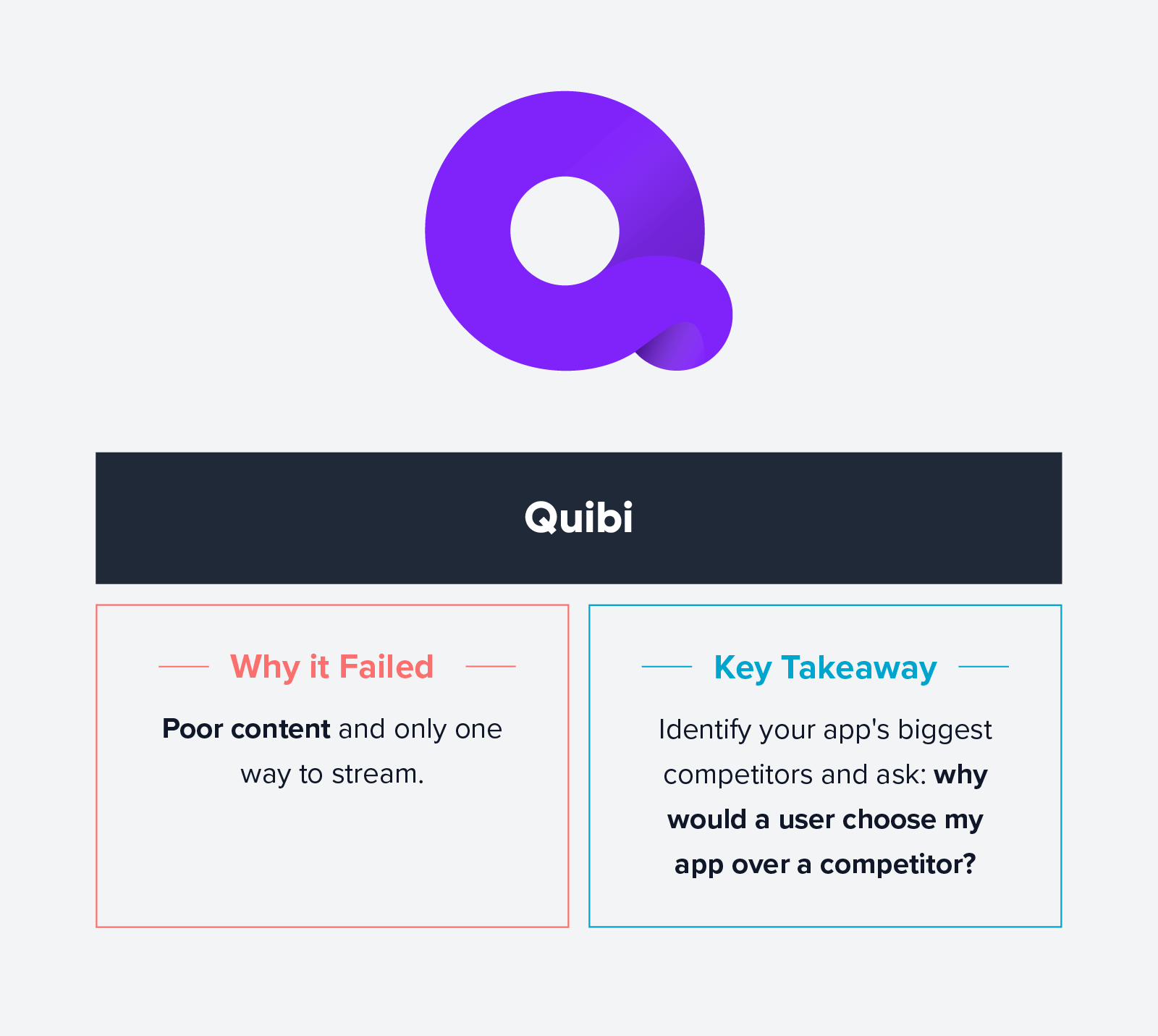
Auctionata
- App Life: 2012 to 2017
- Synopsis: An online auction house that specialized in luxury goods and collectibles
- Market: Ecommerce
- Claim to fame: 250 art experts and $96+ million in funding raised
Why it failed: Here’s a great idea: an app that allows live-streamed auctions for selling artifacts, collectibles, and fine art. Here’s a bad idea: breaching trade regulations. In 2016, a report was released that accused Aucionata of shill bidding and unethical behavior*. After these issues came to light, the app lost the trust of users and had officially lost its value.
Key takeaway: It’s simple: don’t be irresponsible, unethical, or bid against your customers. In addition to adhering to policies, regulations, and codes within your industry, make sure that you are always transparent with your app’s T&Cs and responsible with user data. If you do make a mistake and lose the trust of your users, take the necessary steps to reconcile the issue and learn lessons from the moment.

Blippy
- App Life: 2009 to 2011
- Synopsis: A social network that embraced payment sharing, which refers to sharing your credit card payments with friends and strangers
- Market: Social networking/finance
- Claim to fame: Received backing by Twitter co-founder Evan Williams
Why it failed: Blippy came on the scene BV, i.e., Before Venmo. The concept was just crazy enough to work until a 2010 data breach exposed credit card information to Google. Blippy launched before social and payment oversharing was the ‘norm’ and the data breach definitely didn’t help.
Key takeaway: Apps like Venmo, Instagram, and Snapchat have definitely made oversharing popular, and when done correctly, this tactic and USP can yield the desired results. However, it goes back to the age old question: who cares? If you’re trying to solve a problem that doesn’t exist or make a product that no one wants, your app will become a blip on the radar.
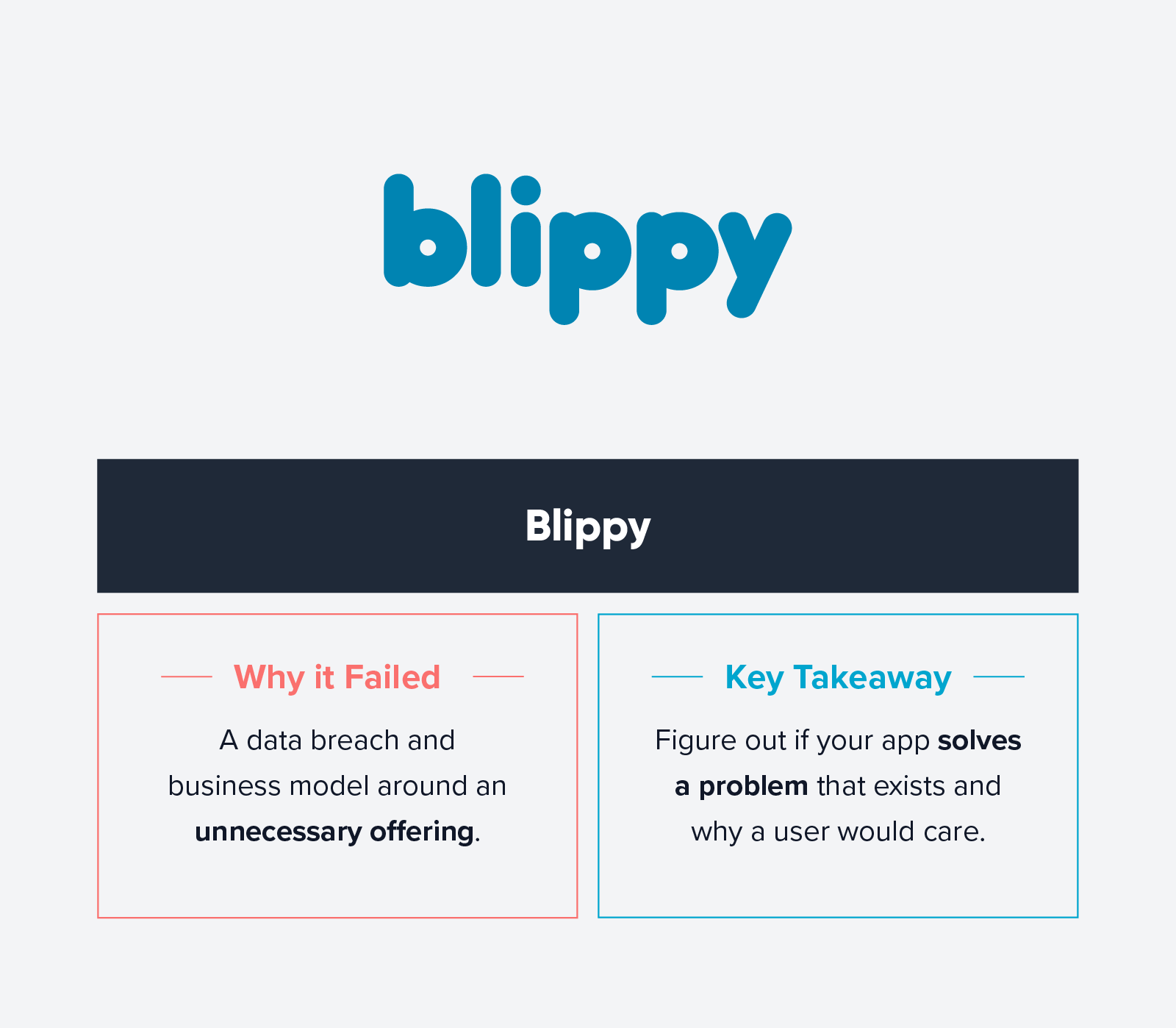
Pay by Touch
- App Life: 2002 to 2008
- Synopsis: An app and system that offered biometric payment service
- Market: Finance
- Claim to fame: Convinced Oracle and Accenture executives to join the business and then raised $340 million in funding
Why it failed: To name a few, irresponsible leadership, lack of market research, and lack of marketing. It is a shame as there was real potential and talent behind its name to be a useful payment service. What’s worse: when Pay by Touch filed for bankruptcy, clients were left in the dark.
Key takeaway: There’s never just one reason an app fails. However, one thing is for certain: never underestimate the importance of effective leadership. Don’t be afraid to invest in ‘think outside the box’ team members and leaders. It’s good to be ahead of the curve but don’t be the app that is too early to the party and asked to leave.

Punch Quest
- App Life: 2012 to present
- Synopsis: An arcade-style fighting game about punching your enemies
- Market: Gaming
- Claim to fame: The app was downloaded more than 630,000 times in its first week
Why it failed: While Punch Quest is still available in the App Store and Google Play, in 2012, it made one giant mistake: the core game offered so much for free that players were understandably hesitant to pay for in-app purchases. The result: despite 600K+ downloads, the game made just over $10,000 in revenue.
Key takeaway: Offering free content, particularly as a teaser or at launch, can be a great marketing tactic. However, this is a great example of a gamble that literally did not pay off. Utilize your customer database and test fee ranges to find out which payment options work best. Test the free-to-play model but if you do offer in-app purchases, they need to be worth it.
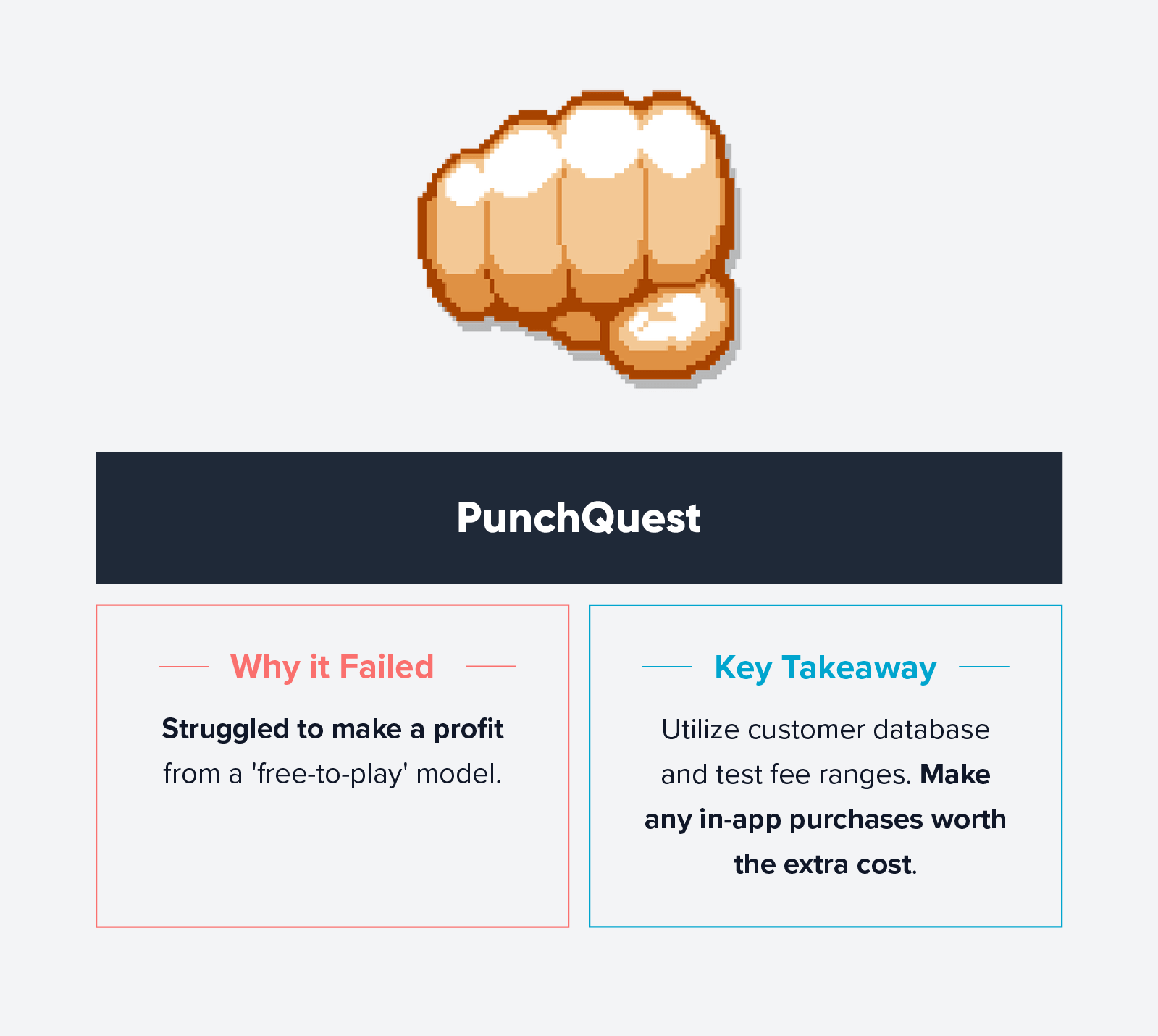
Zulily
- App life: 2010 to 2015 (under original owners)
- Synopsis: A retailer that sells discounted toys and clothing
- Market: Ecommerce
- Claim to fame: At one point, Zuilily was valued at $9 billion
Why it failed: The app didn’t carry well-known brands, but the popularity of the flash sales was enough to generate a buzz and a decent number of subscribers. Yet it was a marketing mistake that contributed in a big way to Zulily’s demise. The app demanded that users share their email addresses before they had the opportunity to properly check out the shop. Result: annoyed customers who shopped once and didn’t return.
Key takeaway: Thanks to marketing channels like push notifications, apps can alert customers of surprise sales. It’s a great marketing tactic to draw in dormant customers and showcase the value that your app can bring to a customer’s life. However, don’t get greedy with your marketing efforts. Apps should never forget that a user sharing their email address is a gift.
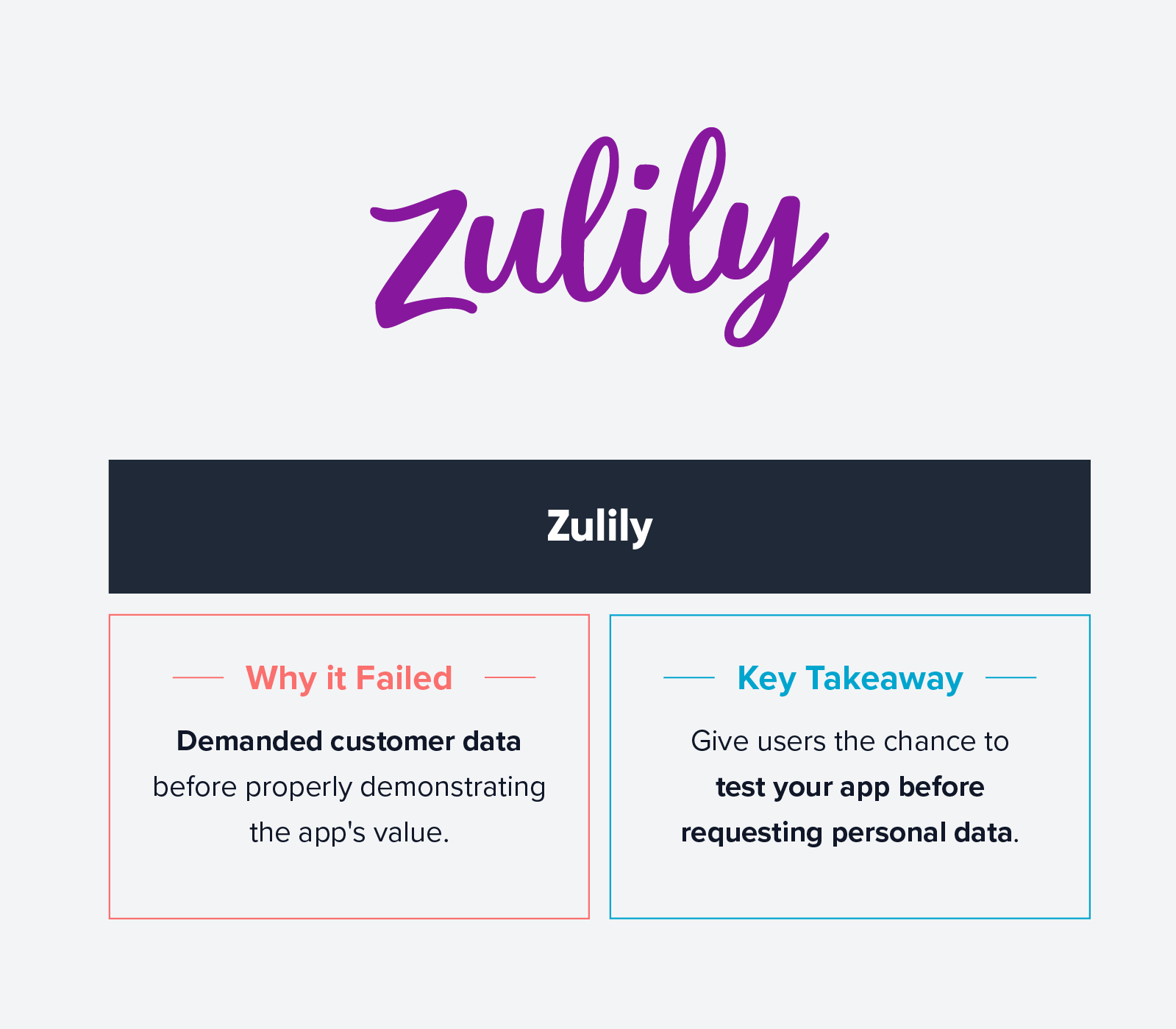
Shyp
- App Life: 2014 to 2018
- Synopsis: Take a picture of your package, upload to the app, and someone would pick it up for a total charge of $5
- Market: Transportation
- Claim to fame: Early coverage in The New York Times and $62 million in funding
Why it failed: Despite being compared to Uber, the app sadly grew too fast and couldn’t keep up with demand. The app failed to adjust its strategy to compensate for this growth, and in the end, it didn’t anticipate how many people would jump at the opportunity to offload a tedious task — mailing a package — for only $5.
Key takeaway: The growth of your app looks good on the surface but if there isn’t enough substance, your app will be the victim of its own success. As the needs of your users evolve, so must your strategy. Don’t just pay attention to industry trends. Anticipate and plan for them.

Google Wave
- App Life: 2009 to 2010
- Synopsis: A real-time messaging platform
- Market: Social networking
- Claim to fame: Generated tons of buzz and was deemed ‘highly anticipated’
Why it failed: Although Google Wave never reached app users, this is an example of a platform launching too early. It also goes to show that a big name like Google isn’t always enough to guarantee success. It was also never totally clear what Google Wave was supposed to be and sadly, after only a year, the wave crashed and burned for the search engine giant.
Key takeaway: Initial buzz for your app is definitely exciting but don’t give in to internal or external pressure to launch your app before it’s ready. It can be tempting to launch while the attention is on your app but if you don’t manage expectations, make your product clear, or properly map out your rollout plan, you and your app will miss the mark entirely.

Like mobile devices, apps have a shelf life. It’s important that your app makes the most of its time in the app store and on a user’s phone. As we become even more dependent on our phones, and by extension apps, the competition will become fiercer and harder to beat. Failure is a part of life and as mentioned above, an app’s failure is never just about one thing.
While this list of app failures isn’t exhaustive, it demonstrates how mismanagement, lack of research, poor delivery, and timing and marketing mistakes can cost you. However, by mastering key processes such as app onboarding and useful notifications like in-app messaging, your app will have a bright future indeed.

The Psychology of Insanely Addictive Apps
Subharun Mukherjee 
Heads Cross-Functional Marketing.Expert in SaaS Product Marketing, CX & GTM strategies.
Free Customer Engagement Guides
Join our newsletter for actionable tips and proven strategies to grow your business and engage your customers.
















































